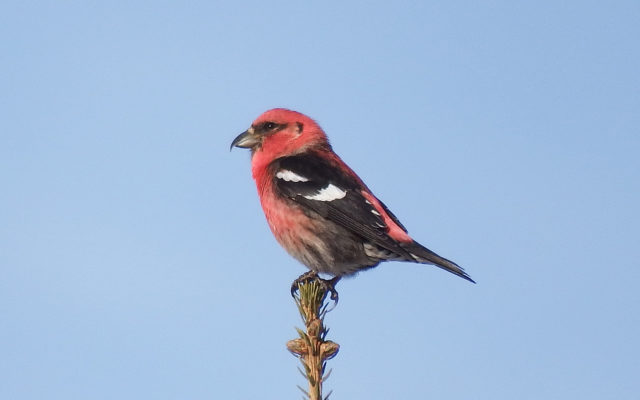
Finches are extra noisy in the North Maine Woods this year. Here’s why.
There’s a symphony going on in the North Maine Woods, and few people know about it. Perhaps a handful of loggers have noticed. A smattering of snowmobilers might have heard the din while pausing on the trail. I rarely run into birders there. Indeed, never.
Right now, and over the next month, an enormous flock of finches is greeting the morning sun with a cacophonous chorus of song. A ton of birds have settled into the Maine forest, for the same reason not many have been coming to your feeders this winter. It was a great seed crop in the treetops last fall, and all the birds are gorging themselves on the abundant natural food.
White-winged crossbills and pine siskins are making most of the noise. Red crossbills and purple finches also add their voices to the morning chorus.

Photo courtesy of Bob Duchesne
HEAR THE BIRDS SING — The white-winged crossbill is one of several species in the finch family that sings loudly in the North Maine Woods.
All finches do it. In some years, American goldfinches settle in the trees above my driveway and fill the air with music. In occasional winters, pine siskins and common redpolls join them in my yard, or replace them. Finches are nomadic. They go wherever the food is. Once they get there, they hang around. In the morning, they sing. A lot.
That’s what’s happening with the crossbills and siskins in the northern forest right now. The avian orchestra starts tuning up as the sun breaks the horizon. The chorus quiets by midmorning, but some birds will sing and call all day.
Crossbills can get romantic any time of year. Even in the dead of winter, the males trill their love songs, either from the treetops, or on the wing during their peculiar flutter flight.
Pine siskins are summer nesters in Maine, but they get feeling frisky as soon as the daylight gets longer. Their songs are a lengthy combination of buzzes and trills.
Purple finches are also musical singers, crooning a long series of warbling notes in the forest. House finches do the same, but these birds are found mostly in suburbia. A house finch wouldn’t be caught dead up in the woods.
All finches are gregarious. They talk to each other a lot. Their call notes are distinctive. Crossbills call repetitive “jip-jips.” The white-winged crossbill jip-jips are more nasal and metallic sounding than the pure jip-jips of the red crossbills. Purple finches do a single jip. Pine siskins call a two-note PEE-you. All of that singing and calling is going on in the woods this winter.
It doesn’t happen every winter. In years when the natural food crop is not so generous, the birds go elsewhere, and the woods are quiet. I used to lead field trips for Maine Audubon to experience this amazing chorus. Then, two years in a row, we drove a long way and found absolutely nothing – a total bust. Now I just go on my own. If the finches are absent, I switch to looking for the more secretive year-round residents.
I have a new excuse, too. You might have heard that Maine is conducting a five-year bird atlas project under the auspices of the Maine Department of Inland Fisheries and Wildlife. It is primarily focused on summer breeding birds, but a winter survey was added this year in order to better understand how northern species are using Maine. It’s easy. Volunteers merely walk winter roads and jot down what they see and hear.
Thus, I spent two February mornings in the woods, walking two survey routes near the Allagash. With all the finches swirling around, it’s hard to avoid double counting. Therefore, I conservatively tallied only the birds ahead of me on the road. I totaled 99 crossbills, 96 pine siskins and 26 purple finches.
When you’re walking a winter logging road, passing drivers routinely stop to ask if you’re OK. A ranger who is headquartered at the Chamberlain Bridge station had just come from Churchill Dam farther upriver. He stopped to chat and reported that the finch chorus at Churchill was even louder than the one at Chamberlain. In truth, the chorus was loud everywhere I went.
The best place to look is around major road intersections. Logging trucks churn up the slush and sand as they turn. The finches like to start their days by gobbling up a little grit to aid digestion. Plus, the water and road salt is more available in such spots. Although finches can be anywhere and everywhere, they definitely hang around intersections in greater numbers. The woodland orchestra gets really loud. It’s a finch fest.
Bob Duchesne serves as vice president of Maine Audubon’s Penobscot Valley Chapter. He developed the Maine Birding Trail, with information at mainebirdingtrail.com. He can be reached at duchesne@midmaine.com.